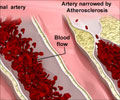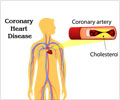A new study suggests that calcium distribution in coronary arteries can help in determining a person's risk of having a heart attack.
Calcium distribution in coronary arteries may provide a clue in determining a person's risk of having a heart attack, a new study has indicated.
The Multi-Ethnic Study of Atherosclerosis (MESA) that began in July 2000 included 6,814 men and women between the ages of 45 and 84.The researchers compared CT image data for 3,252 participants with calcific plaque to data collected from 3,416 patients without calcific plaque.
A calcium coverage score was developed to estimate the percentage of coronary arteries affected by plaque.
The findings revealed that diabetes, hypertension and dyslipidemia (abnormal concentrations of lipids [fats] or lipoproteins in the blood) were highly associated with calcium coverage score,
"Now we know that the location of the calcium in the arteries is particularly important in estimating a patient's potential risk," said the study's lead author Elizabeth Brown, Sc.D., research assistant professor in the Department of Biostatistics at the University of Washington in Seattle.
The researchers also found that calcium coverage score that takes into account the location of the calcium was effective predictor of future cardiac events than currently used measures, which gauge only the amount of calcium present.
Advertisement
On average, compared to patients without diabetes, patients with diabetes had 44 percent more of their coronary arteries affected by plaque.
Advertisement
The study is published in the June issue of the journal Radiology.
Source-ANI
RAS/L











